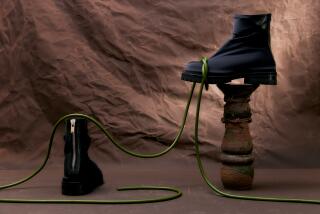‘80s Culture Has Reset Function of Watches : Trends: Timepieces, which were once utilitarian, now sell image as much as time. Designer watches are an especially hot market.
- Share via
When you’re running late for work and desperate to know the time, does it really matter whether your watch is a $100,000 diamond-encrusted Piaget or a $5 no-name piece of Malaysian plastic?
Absolutely.
Your watch tells more than the time. It tells the world who you are--or who you want to be. Your watch is more than a digital or analog movement, a crystal and a strap. It’s you.
That’s exactly how the people who make and sell watches want you to see their timepieces.
When consumers buy a Rolex, Movado or Fossil, “they’re buying a design, they’re buying that look, they’re buying that history,” said Joe Thompson, editor in chief of Modern Jeweler magazine.
One of the hottest looks today is sport watches, which are water-resistant and have chronographs and other features, said Bea Spiech, a merchandising manager at R.H. Macy & Co. Inc.
“The more you have on it, the better,” she said.
Designer watches--with names such as Guess? and Swatch--get hotter and hotter. Even Timex, once hawked by the sonorous tones of John Cameron Swayze, is a top seller.
*
Watches are such big business that Macy’s devoted a 32-page catalogue last summer almost entirely to watches. All the big names were included, from the Tag Heuer on the cover to Raymond Weil, Gucci, Hamilton, Tissot, Swiss Army, Bulova, Seiko, Casio and more.
Everyone wants to sell watches. Carolee, a popular costume jewelry manufacturer, now sells watches. Companies that don’t make watches, such as underwear manufacturer Joe Boxer or outdoor shoemaker Timberland, want their names on one.
It’s hard to say how big the business is. Thompson estimates 900 million watches worth $20 billion are produced globally each year. But because there are “millions of watches no one has ever heard of” coming out of factories in Asia, and millions produced by private companies that don’t report sales figures, no one knows for sure.
Watches with well-known names comprise a fraction of the industry, although they’re the ones that get all the attention.
It used to be that watches were utilitarian. You used them so you could get to work or school on time. You got a nice watch when you graduated from high school, but it wasn’t a big status symbol.
The conspicuous consumption of the 1980s changed the watch business. Along with flashier cars, stereos and clothes, people started coveting and buying watches with names.
*
Anthony D’Ambrosio, a spokesman for Tourneau, a retailer with stores in New York, Florida and California, said expensive watches helped the middle-class person “look like part of the upper class.”
A high-quality, expensive watch was always important to the wealthy person, but the rest of us didn’t see it as a wardrobe essential until the ‘80s, he said.
During the 1970s, the middle class aspired to Seiko and other Japanese watches. In the ‘80s, Swiss watches regained appeal.
Swiss-made brands such as Rolex and Cartier were long admired and coveted for quality and style. But other names, such as Movado, were little known in this country--until savvy marketing campaigns created another generation of must-have watches.
Movado--which while Swiss-made is owned by New Jersey-based North American Watch Corp.--focused on its Museum Watch, with its now-famous black dial and gold dot. The strategy made Movado a top seller and helped other Swiss makers as well.
Well-made Swiss watches run into the hundreds, thousands and up to millions of dollars. But that is not curbing the public’s appetite.
“Price is not an object,” said Macy’s Bea Spiech. “The customer needs a watch that is going to be fashionable and reliable.”
In the higher end, buyers are often drawn to a particular brand by its image. Rolex, Tag Heuer and Breitling are sporty. Cartier has its own classic look.
When a buyer starts moving into the stratospheric levels, such as Piaget, Patek Philippe or Audemars Piguet, they’re usually buying a watch with a lot of 18-karat gold and sometimes diamonds.
D’Ambrosio said the upper-end watches also are much more complicated. They may have “functions not normally seen in everyday or traditional watches,” for example, a perpetual calendar that knows which month has 28, 30 or 31 days. Such a watch may have a gear that turns once every four years, for leap year, he said.
The upper-end watches are handmade, and some have 350 or more parts, compared to 80 to 100 parts in an everyday watch. Yet all these extra parts are contained inside a normal-sized watch case.
Thompson, the Modern Jeweler editor, says Rolex is the top-selling high-end watch, and Seiko has the lead in the middle tier. Timex dominates the low end.
The hottest sellers in the low end are the designer watches, generally retailing between $40 and $100. These watches are aimed at a younger crowd, but people of all ages wear them.
Thompson said Fossil and Guess? have replaced Swatch--which pretty much invented the designer market--as the trendiest watches in this country, but “globally [Swatch] is a great brand and continues to be a great brand.”
Swiss-made Swatch does sell well in the United States. The line, which has come in 1,600 designs since parent company SMH introduced it in 1983, still concocts new twists. They range from fuzzy watchbands to a pair of watches called White Hours and Black Minutes, to be advertised internationally by Spike Lee.
This spring, Swatch introduced its first metal-cased watches, a line called Irony. The company is also expecting a boost from the 1996 Olympics, where Swatch will be the official timekeeper.
Timex’s reputation of stalwart reliability didn’t help the brand in the fashion race, until it devised a shrewd marketing move: Indiglo, a line of watches with faces that light up in blue at night.
“With Indiglo, they’ve made Timex a great brand again,” Thompson said.
Timex also has grabbed part of the designer market by manufacturing the popular Guess? watches. The line has done so well that Timex is making watches for Joe Boxer and sportswear maker Nautica. It’s also bringing out watches this fall for Timberland.
The Joe Boxer watches are reminiscent of Swatch, with designs that carry hidden messages or jokes. One Joe Boxer watch is called “Anti-Diving” and contains liquid inside the crystal, a play on the watches advertised as water-resistant to a depth of 300 meters.






